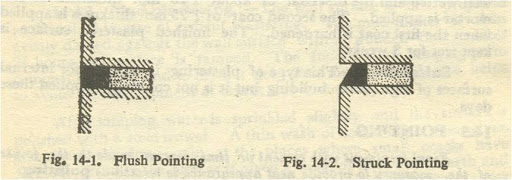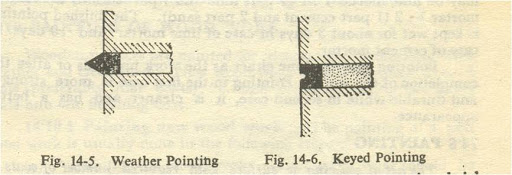Saad Iqbal | 🗓️Modified: April 11, 2017 | ⏳Read Time: 4 min | 👁Post Views: 1018
The joints between bricks in brick masonry are very important from aesthetic as well as structural point of view; because these joints are mostly remained rough and are a basic source through which the moisture penetrates from bottom to top of the wall.
To make this weak point of brick masonry a strong and long lasting strength a treatment is usually done that is called pointing. Today in this post we will be dealing with what is pointing, why the pointing is done, what is the purpose, when the pointing is suitable in brick masonry and what are the different types of pointing in brick masonry.
Pointing
Final treatment with cement or lime mortar made to the joints of the masonry to provide neat appearance is termed as pointing. The joint on the face of stone or brick masonry are roughly filled in while the walls are being raised. They are after wards neatly finished off to make them water tight.
The joints thus finished, give a better appearance to surface and prevent rain water from entering the interior of the masonry.
Purpose of Pointing
To prevent the moisture and the rain water from entering the interior of masonry through joints and to make them durable. To improve the appearance of the structure.
Suitability of Pointing
Pointing is preferred to plastering under following conditions.
1. When a smooth and even surface is not essentially required.
2. Where it is desirable to exhibit to view the natural beauty of the materials (bricks or stones) used in construction.
3. When the workmen ship is neat and good.
Types of Pointing
The selection of particular type of pointing depends upon the types of bricks or stone used and the appearance required.
1. Flat or flush pointing
In this pointing, the mortar is pressed tightly and the joints are filled up and made flush with the face of the wall. This is the simplest type of pointing and is provided extensively. It is economical and durable because it requires less labor than all other pointing. It does not afford a lodging place for dust.
2. Struck pointing
In this pointing the face of the mortar joint instead of keeping it vertical, its upper side is kept about 12 mm inside the face of the masonry and the bottom is kept flush with the face of the wall as shown in fig 14.2. This pointing has a better effect of throwing rain water. This is also known as ruled pointing. This pointing is the best in ordinary circumstances.
3. Recessed pointing
In this pointing the face of the mortar joint is pressed inside by means of a suitable tool and is left vertical instead of being made inclined. This pointing is provided when face work of good textured bricks with good quality mortar is used.
4. V-pointing
This type of pointing is provided by forming a v-shaped groove inside the mortar of the joint with a special tool (steel or iron jointer). This pointing is commonly recommended for brick work in case of governmental buildings.
5. Weather pointing
This is similar to V-Pointing but in this case instead of pressing a v shaped groove inside, it is provided by forming a v shaped projection outside the wall’s surface. This pointing is generally recommended for superior brick work.
6. Keyed or grooved pointing
In this case, the joints are first filled up flush, and then a circular piece of steel or iron is pressed in and rubbed in the middle of joints. Grooved pointing has a big groove in the face than keyed.Keyed pointing gives an attractive appearance to the structure and is generally used for superior work.
7. Tuck pointing
In this pointing, the mortar joints are filled with the face of the wall. Then 6 mm wide and 3 mm deep groove is immediately and carefully formed in the centre of the joint and the groove is filled with or tucked in with white lime putty. The lime putty is given a maximum projection of 6 mm. Tuck pointing has a neat attractive appearance. But the lime putty is not durable and in due course of time becomes defective.







